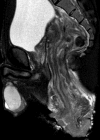Rectosigmoid carcinoma presenting as full-thickness rectal prolapse
- PMID: 31892618
- PMCID: PMC6954742
- DOI: 10.1136/bcr-2019-230409
Rectosigmoid carcinoma presenting as full-thickness rectal prolapse
Abstract
A 34-year-old man with recent-onset constipation presented with colonic obstruction due to a palpable rectal tumour. Colostomy relieved the obstruction and biopsy revealed carcinoma. During workup, full-thickness rectal prolapse occurred with the tumour at the apex of an intussusception. Imaging revealed a low rectal tumour and no metastases. An abdominal oncological rather than perineal resection of the rectum was planned. At laparotomy, the tumour was reduced and was seen to originate at the rectosigmoid junction. Surgery was successful and follow-up has been clear. Histology revealed an adenocarcinoma with microsatellite instability. Rectal prolapse due to tumour intussusception is very rare. In this young man, it was due to straining at stool because of constipation and tenesmus rather than pelvic floor abnormality. An associated colorectal tumour should be considered in patients with rectal prolapse. In such cases, surgical and adjuvant management may need to be modified.
Keywords: colon cancer; general surgery.
© BMJ Publishing Group Limited 2019. No commercial re-use. See rights and permissions. Published by BMJ.
Conflict of interest statement
Competing interests: None declared.
Figures
References
-
- Hussain D, Baliga SK, Al-Madhi S, et al. . Malignant gastrointestinal stromal tumor of the rectum with prolapse. Saudi Med J 2007;28:1291–2. - PubMed
Publication types
MeSH terms
LinkOut - more resources
Full Text Sources
Miscellaneous



